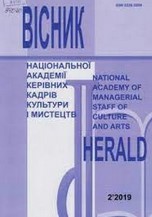МОТИВ ЄВХАРИСТІЙНОЇ ЧАШІ В ДЕКОРАТИВНОМУ РІЗЬБЛЕННІ ЦАРСЬКИХ ВРАТ СХІДНОГО ПОДІЛЛЯ
MOTIF OF EUCHARISTIC CHALICE IN DECORATIVE CARVING OF ROYAL GATES OF EASTERN PODILLIA
Author(s): Iryna KhodakSubject(s): Architecture, History of Church(es), Visual Arts, History of Art
Published by: Національна академія керівних кадрів культури і мистецтв
Keywords: Church; iconostasis; royal gates; chalice; decorative carvings; Eastern Podillia;
Summary/Abstract: The purpose of the article is to identify and classify the royal gates of Eastern Podillia with the Eucharistic chalice, to characterize the principles of images, determine semantics, and outline the territorial and chronological boundaries of spreading the motif. The research methodology combines the methods of archival heuristics with the artistic analysis of works. Scientific novelty: for the first time, six royal gates of the 18th century with a motif of the chalice, originating from the iconostasis of the churches of Eastern Podillia, are considered. The localisation, ornamental context and semantics of the motif are clarified. The territorial and chronological boundaries of its spreading in the region are determined. Conclusions. The analysed material confirms that the Eucharistic chalices were quite often introduced into the decor program of the royal gates of Eastern Podillia, and they mainly played the role of the organising composition factor since they were placed symmetrically on the lower bar of the sashes and only occasionally on the sash column. In most cases, the grapes were removed directly from the chalice, in one case they hung on both sides, i.e. in all sights (regardless of style definition), the Eucharistic and Christological symbols of the vessel were unveiled. The royal gates with the considered image cover the south, northwest and centre of the Vinnytsya region, as well as the border territories of neighbouring regions in the same locations (northwest, south-east directions). Although the sights are not dated, taking into account their stylistic features and information about the date of the temples' construction, it can be stated that the motif of the chalice in the region was used throughout the 18th century, and it was simultaneously introduced into the decor of the sashes and sash column. The material introduced into the scientific area expands the established ideas about the chronological and territorial limits of existing the motif and prompts a critical attitude to the hypothesis about the cultural and historical reasons for its introduction and extinction, respectively.
Journal: Вісник Національної академії керівних кадрів культури і мистецтв
- Issue Year: 2022
- Issue No: 3
- Page Range: 124-129
- Page Count: 6
- Language: Ukrainian

